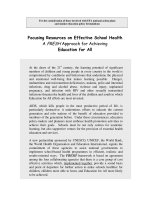Mental Health Handbook for Schools doc
Bạn đang xem bản rút gọn của tài liệu. Xem và tải ngay bản đầy đủ của tài liệu tại đây (1.01 MB, 294 trang )
This handbook is a practical, accessible guide to the promotion of good mental health in
schools. It provides teachers with up-to-date information on childhood and adolescent
mental health problems commonly encountered in schools, and offers practical suggestions
for identifying and supporting pupils with specific mental health difficulties.
The book focuses on a range of childhood and adolescent mental health problems and the
circumstances which can lead to these difficulties, including:
• ADHD
• suicidal behaviour and deliberate self-harm
• eating disorders
• obsessive–compulsive disorder
• anxiety disorders
• autism
• substance abuse
• parental separation and divorce
• depression
• bullying
• schizophrenia
• bereavement.
The handbook is an invaluable resource for all schools. It includes essential information
about child and adolescent mental health services and outlines a whole-school approach
to the promotion of good mental health. It will prove indispensable for all teachers,
special educational needs co-ordinators, heads of year, PSHE co-ordinators, education
welfare officers and educational psychologists.
Mary Atkinson is a Senior Research Officer with the National Foundation for
Educational Research (NFER). Garry Hornby is a Reader in Education at the Institute for
Learning, University of Hull, and co-author of The Special Educational Needs Co-ordinator’s
Handbook (Routledge, 1995).
Mental Health Handbook for Schools
Mary Atkinson and Garry Hornby
London and New York
Mental Health Handbook
for Schools
First published 2002
by RoutledgeFalmer
11 New Fetter Lane, London EC4P 4EE
Simultaneously published in the USA and Canada
by RoutledgeFalmer
29 West 35th Street, New York, NY 10001
RoutledgeFalmer is an imprint of the Taylor & Francis Group
© 2002 Mary Atkinson and Garry Hornby
All rights reserved. No part of this book may be reprinted or
reproduced or utilised in any form or by any electronic,
mechanical, or other means, now known or hereafter
invented, including photocopying and recording, or in any
information storage or retrieval system, without permission in
writing from the publishers.
British Library Cataloguing in Publication Data
A catalogue record for this book is available from the British Library
Library of Congress Cataloging-in-Publication Data
Atkinson, Mary, 1954–
A mental health handbook for schools / Mary Atkinson and Garry Hornby.
Includes bibliographical references and index.
1. Children–Mental health–Handbooks, manuals, etc. 2. Teenagers–Mental
health– Handbooks, manuals etc. 3. Students–Mental health
services–Handbooks, manuals, etc. I. Hornby, Garry. II. Title.
[DNLM: 1. Mental Disorders–Adolescence. 2. Mental Disorders–Child. WS 350
A877m 2002]
RC454.4 .A86 2002
618.92'89–dc21 2001040809
ISBN 0–415–20829–7
This edition published in the Taylor and Francis e-Library, 2005.
“To purchase your own copy of this or any of Taylor & Francis or Routledge’s
collection of thousands of eBooks please go to www.eBookstore.tandf.co.uk.”
(Print Edition)
ISBN 0-203-99486-8 Master e-book ISBN
Foreword vii
Preface ix
Acknowledgements xii
PART I
Mental health in context 1
1 Introduction 3
2 Normal and abnormal development 13
PART II
Recognised mental health disorders 31
3 Conduct disorder 33
4 Attention deficit hyperactivity disorder 46
5 Eating disorders 59
6 Anxiety disorders 71
7 Substance abuse 85
8 Depression 100
9 Suicidal behaviour and deliberate self-harm 111
10 Soiling and wetting 124
11 Obsessive–compulsive disorder 136
Contents
12 Schizophrenia 147
13 Autism 160
14 Special educational needs 173
PART III
Psychological reactions to adverse situations 185
15 Bullying 187
16 Parental separation and divorce 199
17 Bereavement 210
18 Child abuse and neglect 224
19 Post-traumatic stress 238
PART IV
Promoting mental health and services for children 251
20 Mental health services for children and adolescents 253
21 Promoting mental health in schools 263
Index 278
vi Contents
Schools are such an ordinary part of our everyday experience that it is all too easy for us to
overlook how extraordinary they are. Entrusted implicitly with the well-being of our
young, they are required to take on the formidable task of enriching, cultivating and
educating the minds of increasingly diverse groups of human beings. They are first and
foremost places of learning, of building competencies and academic achievement; but they
are also places of safekeeping, of care and encouragement in creating the health and the
confidence necessary for future independence in adulthood. Schools have many functions,
meeting a wide range of needs in a broad spectrum of young people. A Department of
Education circular in 1994, called Pupils with Problems, made it clear that ‘schools … play
a vital part in promoting the spiritual, cultural, mental and physical development of young
people … the emotional development of children must continue to be a concern of main-
stream education’. More recently, in a consultation document, entitled Schools: Building
on Success, the department has emphasised the importance of ‘establishing Education
with character in schools’. Amongst other things, it states that schools should provide
opportunities for pupils to ‘develop as well-rounded, creative, self-reliant individuals, who
know right from wrong, who can work in teams, who respect their fellow pupils whatever
their background, who are able to manage their own learning …’. All of this is to be much
commended, but we do need to acknowledge how much it adds up to a very tall order –
and the teachers who work in the schools need all the training and support they can get to
meet such high and important aspirations. At the heart of this book is a deep concern for
this need and a full recognition of the breadth of responsibility that the teachers carry for
both the mental health and education of their pupils.
‘Mental health’ and ‘education’ – these are words and concepts that over time have
rarely sat comfortably with each other. The word ‘mental’ has had its immediate popular
association with madness, giving rise to all kinds of fears about loss of control and self-
coherence and of stigmatisation. ‘Education’ has had a more favourable reception, but for
many it has too rapidly been linked to academia, with little reference to ‘health’. A crude
divide has occurred in our thinking about emotion and intellect, to a large extent fostered
in the histories, trainings and preoccupations of those who engage in the separate world of
schools and mental health services. Much of this may well have been necessary in the
past, but increasingly it is being seen as unhelpful, serving only to obscure one or two
simple truths that, if more fully accepted, would be of inestimable value in child develop-
ment. It is, for example, in the very process of education that physical and mental health
are enhanced; equally it is out of physical and mental health that the learning potential of
individuals is increased.
Foreword
Peter Wilson, Director, Young Minds
It is with this sense of integration in mind, that Mary Atkinson and Garry Hornby
have written this important and innovative book. They clearly understand the meaning of
mental health – that it is more than merely the absence of illness; and they well recognise
the pivotal and unique role that teachers play in promoting mental health in general
throughout their schools, as well as preventing mental health problems from arising, and
also dealing with them when they have become established. The authors are not, of
course, suggesting that teachers become specialist therapists or quasi psychiatrists; nor are
they losing sight of the teacher’s primary educational purpose. They are, however, high-
lighting the major contributions that teachers can make – through their day-to-day
knowledge of their pupils; through their ways of being with and responding to them;
through their experience, expertise and sheer familiarity and availability – to the
emotional and social well-being of their pupils.
This book honours this contribution by providing a remarkably coherent and compre-
hensive manual that will enable teachers to understand better the extraordinary
complexity of the children and young people who come to them – in all the different
shapes and sizes of their minds and experiences, from such diverse family and social back-
grounds and with such variety of ability, talent and expectation. The manual will help
teachers find their bearings, make better use of their own perceptions and form clearer
judgements about the problems that they face. It will equip them with the knowledge to
make more effective and appropriate decisions – how best to teach children with certain
kinds of mental disorder or special need, how to alert parents and others quickly to
emerging problems and how to make effective referrals for help elsewhere.
The value of this book lies in its readiness to hold together the particular and the
whole. It is unequivocal in its determination to draw into the field of education a full and
detailed account of the different forms of mental disorder – using the language and under-
standing of formal psychiatric classification. This is a bold move, crossing the waters from
one domain to another, but absolutely essential, if teachers are to recognise and differen-
tiate between the symptoms and behaviour of the children they meet, with different kinds
of personalities and problems. At the same time the book keeps alive the context in which
these disorders and problems occur and in which teachers, parents and others can work
together. The potential of a school – through its ethos, its whole school policies and its
pastoral provision and classroom management – to build a community of people in which
everybody, young and old, feels fundamentally respected and encouraged, their differences
welcomed and their difficulties understood, is enormous. All of this is very much captured
in the realistic optimism, clear thinking and writing and sustained sense of endeavour in
this book. It sets a standard and offers an invaluable guide to reaching that standard, in
the best interests of improving the quality of school life in general and of strengthening
the capacities of teachers, who, let’s face it, are crucial to the development of the minds of
our children.
References
Department for Education (DFE) (1994) Pupils with Problems, Circulars 8–13/94. London: HMSO.
Department for Education and Employment (DfEE) (2001) Schools: Building on Success. Norwich:
Stationery Office.
viii Foreword
The idea for this book arose from our own experience of working alongside mainstream
teachers in supporting them to address the needs of children and adolescents with mental
health problems. On the one hand, in the first author’s case, this was as a teacher within a
child and adolescent mental health unit offering advice to mainstream teachers on pupils’
return to school. On the other, in the second author’s case, this was as an educational
psychologist providing guidance to teachers on dealing with pupils with emotional and
behavioural difficulties.
In addition, our experience in the early days of our teaching careers led us to believe
that many mainstream teachers lacked awareness of children’s mental health problems
and, at times, even experienced teachers felt out of their depth when confronted with
pupils with such problems. When working as a teacher in a class for children with learning
difficulties, for example, the second author’s own lack of knowledge was highlighted when
a pupil developed symptoms of schizophrenia and he was uncertain how to help. Through
our own experience and training we became aware of many pupils whose emotional or
behavioural needs were unmet because teaching staff lacked the necessary knowledge,
understanding and skills. In these situations they appeared uncertain about the approach
they should adopt and were concerned that they might exacerbate these children’s diffi-
culties. This was not helped by the fact that mental health professionals were often
reluctant to share information with teachers or to acknowledge the constraints that
teachers were under when working with these children in a mainstream school setting. It
was evident that teachers required more knowledge and understanding of children’s
mental health problems and of the potential strategies for addressing such difficulties. Our
training and experience have led us to believe that teachers can do a lot more to improve
children’s mental well-being if they have greater knowledge and understanding of the
mental health problems they are likely to encounter.
The central message in this handbook is a hopeful one. Whilst not all children recover
fully from serious mental health disorders, as Clarke and Clarke (2000: 19) state, in their
review of research evidence for the long-term effects of early experiences: ‘There is no
known adversity from which at least some children had not recovered if moved to some-
thing better.’ For many children, therefore, despite adverse circumstances, there is much
hope. They state too that: ‘The whole of the life path is important, including the early
years.’ It is never too late to help children with mental health problems, no matter how
serious their symptoms and how adverse their circumstances may seem. This is poignantly
illustrated by the recent international best selling book A Child Called It by Dave Pelzer
(2000). Despite appalling circumstances of child abuse and neglect throughout his
Preface
childhood, Dave went on to live a happy and satisfying life. Whilst this must in part be
credited to his own strength and resilience, the central role that teachers played in his
survival is confirmed by the fact that he dedicated the book to his teachers.
The need for a book that bridges the divide between mental health and education is
long overdue. In writing the book, we set out to:
• raise teachers’ awareness of the importance of mental health in children and adoles-
cents, how this may impact on their learning potential, and the link between mental
health and special educational needs;
• increase teachers’ knowledge of the range of mental health problems and disorders
they may encounter, the criteria by which they can be identified, and strategies they
might employ to address them;
• present teachers with a range of strategies aimed at preventing mental health problems;
• raise teachers’ awareness of the way in which liaison between Child and Adolescent
Mental Health Services and schools can be improved and how both services can work
together to address the mental health needs of children and young people.
It is envisaged that the handbook will be a useful guide for practising teachers to dip into
when mental health difficulties are encountered and will also inform aspects of whole-
school development, both policy and practice. In addition, it will be of assistance to
professionals involved in supporting teachers and pupils with emotional and behavioural
difficulties, such as special educational needs co-ordinators, educational psychologists,
education welfare officers and behaviour support teachers. Finally, it will provide a useful
text for students on post-graduate courses in education. The handbook is divided into four
parts.
Part I is an introductory section. The first chapter provides a general introduction to
children’s mental health problems. The second chapter focuses on the distinction between
abnormal and normal child development, particularly emotional development, theories of
mental health and classification systems. Both chapters were considered important to
include as a background against which to discuss more specific mental health problems.
Part II includes detailed accounts of most of the common childhood and adolescent
mental health problems which teachers are likely to encounter. The decision about what
to include and what not to include was very much based on the authors’ own experiences
of the children and young people they had encountered in mainstream school settings.
Each chapter is divided into two sections. The first section provides an overview of the
current information with regard to diagnosis, features, incidence, causes, treatment and
outcome of the disorder in question. The second section of each chapter discusses strate-
gies teachers can employ by way of prevention and early identification, as well as
intervention for pupils recognised as having the disorder.
In Part III specific circumstances that pupils may encounter that are likely to lead to
mental health problems are discussed. Again, the first section in each chapter deals with
current information with regard to definition, features, incidence, effects, causes, treat-
ment and outcome. The second section focuses on ways in which teachers can help to
alleviate and address the difficulties associated with these circumstances in order that
more serious mental health problems might be prevented.
Part IV focuses on mental health services and the prevention of mental health prob-
lems in children. In the penultimate chapter information about Child and Adolescent
Mental Health Services is provided, together with a discussion of some of the issues that
x Preface
may arise in collaboration between teachers and mental health professionals. The final
chapter outlines a whole-school approach to the promotion of mental health in schools
and discusses the role that teachers can play in this.
References
Clarke, A. M. and Clarke, A. D. B. (2000) Early Experience and the Life Path. London: Jessica
Kingsley.
Pelzer, D. (2000) A Child Called It. London: Orion.
Preface xi
There are a lot of people who have contributed to this handbook, many without knowing
it. It is impossible to thank them all here. However, the first author would personally like
to thank all the children and families encountered during her time as a teacher at the
West End Adolescent Unit in Kingston upon Hull, for the inspiration to embark on this
book. She would like to thank the staff at the unit, from whom she learned so much. Both
authors are indebted to Dany Wlodarcyk, Marcia Pilgrim and Jennifer Karn for taking the
time and trouble to read and comment on drafts of chapters of the book. Their feedback
was most helpful. We would like to thank Mandy Maull for her contribution to the
cameos of children at the beginning of each chapter. These are based on actual cases with
the names changed to preserve anonymity. In addition, thanks go to Steven Morris for the
support received throughout the production of this book.
We are grateful to the American Psychiatric Association and all diagnostic criteria is
reprinted with permission from Diagnostic and Statistical Manual of Mental Disorders, Fourth
Edition. Copyright 1994 American Psychiatric Association.
Acknowledgements
Part I
Mental health in context
A leading authority on mental health in children in the UK has estimated that, in the
average secondary school of around a thousand pupils at any one time there will be fifty
students who are clinically depressed, a further hundred with significant emotional diffi-
culties, ten affected by eating disorders and up to ten who will attempt suicide in the next
year (Mind, 1997). The importance of mental health in children and young people is
highlighted by recent concern about increases in:
• children with disruptive behaviour being excluded from schools;
• violence in schools and juvenile crime;
• psychosocial disorders in young people;
• suicides and incidences of self-harm among children and adolescents;
• the numbers of children affected by marital breakdown;
• the numbers of children involved in substance abuse;
• the incidence of children subjected to abuse or neglect.
Despite these factors, children’s mental health has so far been paid insufficient attention
in schools. Teachers are uniquely placed to influence the mental health of children and
young people. As well as being in a position to recognise the symptoms of mental health
difficulties at an early stage, they can enhance the social and emotional development of
children and foster their mental well-being through their daily responses to pupils.
According to the Mental Health Foundation (1999), schools have ‘a critical role to play’
in these aspects of mental health. In addition, Rutter (1991) provides evidence that
school experiences are important for children’s psychological, as well as their intellectual,
development and asserts therefore that schools need to concern themselves with children’s
self-esteem and their social experiences, as well as their academic performance. So, to
suggest that schools need to focus on mental health issues ‘is not simply to add yet another
demand to a teacher’s already impossible workload; effective social and affective education
is directly beneficial to academic attainment and can therefore help teachers be more
effective’ (Weare, 2000: 6).
The majority of children with mental health problems never reach specialist services so
their needs have to be addressed by mainstream institutions, such as schools. At the same
time, current pressures on schools, such as the demands of the National Curriculum, make
it more difficult for teachers to address the emotional and social needs of pupils. Whilst it
is desirable that children achieve academic success, personal and social development are
also vital if they are to grow into well-adjusted adults. The inclusion of children with a
1 Introduction
wide range of special needs in mainstream schools means that today’s teachers must also
support many troublesome and troubled children, whose needs are not easily met.
Although some teachers may consider that meeting the mental health needs of children
does not fall within their remit, unmet emotional needs inevitably impact on children’s
learning and make the task of teaching more difficult. So it is therefore important for
teachers to directly address children’s mental health needs.
Many mainstream teachers lack awareness of children’s mental health issues. They lack
the necessary knowledge, understanding and skills for addressing the needs of children
with mental health problems. At times, even very experienced teachers can feel out of
their depth when faced with such pupils. They may be uncertain about the approach they
should adopt or have concerns that whatever they do may exacerbate these children’s
difficulties. This dilemma is sometimes reinforced by the reluctance of health professionals
to share information with teachers and their failure to acknowledge the constraints that
teachers are under when working with these children in a mainstream school setting.
It is important that teachers have more knowledge and understanding of children’s
mental health problems and that they are aware of potential strategies for addressing
them. With increased knowledge, training and experience, teachers can do a lot more to
improve children’s mental health.
This handbook spans the boundary between mental health and education. In doing so,
it is hoped that it will provide the information and guidance teachers need to help pupils
with mental health problems. They must also be able to recognise, however, the limits of
what they can achieve alone, as well as the indications that children should be referred for
more specialist help. When working with pupils with diagnosed mental health disorders, a
teacher’s role should be complementary to that of mental health workers, with whom they
will need to liaise closely.
Definitions
Most teachers will be aware of pupils with emotional and behavioural difficulties (EBD),
but there is often considerable uncertainty about the boundaries between ‘normal’ misbe-
haviour, emotional and behavioural difficulties, and mental illness. Within DFE Circular
Number 9/94 (DFE, 1994a: 4) children with EBD are described as being on a continuum,
with their difficulties lying between ‘occasional bouts of naughtiness’ at one end and
‘mental illness’ at the other. When assessing children, whether they have EBD will depend
on ‘the nature, frequency, persistence, severity, abnormality or cumulative effect of the
behaviour’ compared with normal expectations for children of their age. EBD can take a
wide variety of forms. The Special Educational Needs Code of Practice (DFE, 1994b)
refers to withdrawn, depressive or suicidal attitudes, obsessional preoccupation with eating
habits, school phobia, substance misuse, disruptive, antisocial and uncooperative
behaviour, as well as frustration, anger and threats of violence.
Teachers, however, are rarely able to articulate a clear definition of EBD (Daniels et al.,
1999). Hyperactive children, for example, are frequently described as naughty. Teachers
may find it difficult to assess where on the continuum between ‘occasional bouts of naugh-
tiness’ and ‘mental illness’ children lie. They need, however, to be able to distinguish
between them in order to be able to take appropriate action. The relationship between
EBD, mental health problems and mental health disorders can be conceptualised as on a
continuum (Weare, 2000), as illustrated in Figure 1.1.
4 Mental health in context
Many children exhibit occasional episodes of disruptive or withdrawn behaviour, but
for some children these episodes will be severe enough and persistent enough to be consid-
ered as evidence of EBD. The difficulties of a proportion of the children with EBD will
also be sufficiently severe to constitute a mental health problem, for example children
who are diagnosed as clinically depressed. Similarly, some of these children’s difficulties
will be considered so extreme that they warrant classification as a mental health disorder,
such as schizophrenia. Therefore, whilst EBD affect a relatively large number of pupils,
mental health disorders affect a relatively small, but still a significant, number of children.
One would also expect to find a far higher degree of mental health problems within a
group of children already identified as having EBD than in a randomly selected group of
children, which is in fact the case. Mental health problems and EBD also share common
risk factors, which are discussed in more detail later in this chapter.
A mental health problem is defined as ‘a disturbance of function in one area of rela-
tionships, mood, behaviour or development of sufficient severity to require professional
intervention’ (Wallace et al., cited in the Department of Health, 1995: 10). A mental
health disorder is defined as ‘a severe problem (commonly persistent), or the co-occurrence
of a number of problems, usually in the presence of several risk factors’ (ibid., 1995: 10).
The Department of Health (1995) stated that the significance of a mental health problem
could be determined by:
Introduction 5
Figure 1.1 The relationship between EBD and mental health disorders
• its severity
• its complexity
• its persistence
• the risk of secondary handicap
• the child’s stage of development
• the presence or absence of protective and risk factors
• the presence or absence of stressful social and cultural factors.
An understanding of the distinction between occasional withdrawn or disruptive
behaviour on the one hand and EBD, mental health problems and disorders on the other
is a crucial one. The severity and persistence of the problem need to be taken into account
otherwise inappropriate responses may be adopted. A child who is persistently withdrawn
following bereavement and has difficulty concentrating on his or her schoolwork, for
example, may be perceived as lazy, or a child with a conduct disorder may be rejected
because of his or her disruptive behaviour. As a result, vulnerable children may be further
alienated from those who could provide them with the understanding and support that
they need to help alleviate their problems. Educational policies that focus mainly on chil-
dren defined as having EBD may result in children who have more internalising disorders,
such as depression and anxiety, being neglected (Mental Health Foundation, 1999). This
is because their difficulties are less obvious and cause teachers and other pupils fewer prob-
lems than children with externalising problems, such as behavioural difficulties.
The importance of children’s mental health
A high priority has recently been placed on addressing the mental health needs of chil-
dren and adolescents (Department of Health, 1995) because:
• mental health difficulties cause distress and may impact on many or all aspects of chil-
dren’s lives and, as well as affecting children’s emotional development, they may
affect their physical and social development and their educational progress;
• children’s mental health difficulties have implications for all those involved in their
care, as well as those who come into contact with them on a daily basis, such as
teachers and other pupils;
• problems unresolved at this early stage can have long-term implications and may lead
to a disrupted education, poor socialisation and a lack of mental well-being in adult-
hood;
• mental health problems in children increase demands on other services, such as social
services, educational and juvenile justice services.
There is growing awareness of the impact of school experiences on children’s mental well-
being. School years are a vital period in children’s lives, particularly for their emotional
development, and a safe and secure environment is essential for them to grow up happy
and confident. Teachers, among others, should encourage children to form healthy and
effective relationships, help them to achieve their potential and should prepare them for
increasing independence. Children can, however, experience a variety of pressures and
difficulties during their school years. Some have difficulty coping with these challenges
and this can have a serious effect on their lives in the future.
6 Mental health in context
The prevalence of mental health problems
Mental health problems are relatively common in children and adolescents, although
severe mental illness is rare. It has been suggested that 20 per cent of children display
some sign of poor mental health and a proportion of these may require professional help
for mental health problems at some time (Department of Health, 1995; Mental Health
Foundation, 1999). The prevalence rates of specific disorders are discussed in more depth
in individual chapters. There is good evidence to suggest that the prevalence of psychi-
atric disorders in children and adolescents is similar in all developed countries. Within
most ethnic minority groups in the UK the rates of psychiatric problems are generally
similar to those of the general population, although the circumstances that lead to them
may differ. In the African–Caribbean population, however, higher rates have been found.
The prevalence of mental health disorders varies with the type of problem and the age
and sex of the child. The most common mental health disorders are conduct disorders and
emotional disorders, which are found in about 10 per cent of 10-year-old children. Some
problems, such as feeding and sleep difficulties, appear to be relatively common in young
children, whilst others, such as bed wetting and temper tantrums, although still found in a
significant proportion of children, appear to be relatively less common. Some problems,
such as obsessive–compulsive disorder, eating disorders, suicide and attempted suicide and
substance misuse, are particularly prevalent during adolescence, whilst others, such as
soiling, become less common with increasing age. This highlights the relevance of a devel-
opmental approach to tackling mental health problems. Developmental issues are
discussed in some depth in Chapter 2 of this handbook.
A Europe-wide increase in the incidence of a range of psychosocial disorders, including
depression, suicide, delinquency, eating disorders, and drug and alcohol abuse, has been
reported (Fombonne, 1998). Several studies also suggest an earlier age of onset for these
disorders. This has implications for all professionals working directly with children and
young people, especially teachers. Society is becoming more complex and families are less
able to cope. Parents may be unavailable, whether through bereavement, divorce, illness
or deprivation, to promote their children’s growth and development and this can have
serious consequences. Children respond to these difficulties in various ways – they may
become aggressive or withdrawn, they may feel anxious or afraid. These reactions can
manifest themselves through sleep and eating problems, difficulties in learning, difficulties
in forming relationships, depression or even attempted suicide.
Factors influencing the mental health of children
There is no easy way of telling whether children will develop mental health problems or
not. Some children maintain good mental health despite traumatic experiences, whilst
others develop mental health problems even though they live in a safe, secure and caring
environment. There are, however, some common risk factors that increase the probability
that children will develop mental health problems. These include individual factors, such
as a difficult temperament, physical illness or learning disability, family factors, such as
parental conflict and inconsistent discipline, and environmental factors, such as socio-
economic disadvantages or homelessness (Mental Health Foundation, 1999). Risk factors
are cumulative. If children are exposed to one risk factor the likelihood of developing a
mental health problem is between 1 and 2 per cent, but with four or more risk factors this
increases to 20 per cent.
Introduction 7
Stressful life events will affect some children more than others. An important key to
promoting children’s mental health is a greater understanding of the protective factors
that result in some children being more resilient than others. Factors that protect children
against mental health problems also include individual factors, such as being more intelli-
gent and having an easy temperament, family factors, such as good relationships with
parents and an educationally supportive family, and environmental factors, such as a good
support network and positive school experiences (Mental Health Foundation, 1999). The
more protective factors the child experiences the greater the likelihood of mental well-
being.
There is a complex interaction between the range of risk factors, their interaction with
each other and with any protective factors, and this relationship is not clearly understood.
However, children’s risk is greatly increased when adverse environmental circumstances,
adverse family relationships and their personal characteristics reinforce each other.
Research clearly suggests that as the disadvantages and the number of stressful circum-
stances accumulate, more protective factors are needed to compensate for this. Whilst
biological factors may predispose children to some types of mental health difficulties,
social circumstances, such as unemployment, divorce and stressful life events, and educa-
tional factors, such as their achievement and the school environment, are an important
influence. An understanding of the main influences on children’s mental health can lead
to effective treatment measures at child, family and environmental levels. There is also
considerable correlation between these influences and later mental health difficulties,
poor education outcomes and antisocial behaviour. These influences, therefore, are the
concern of teachers, as well as health professionals, and by enhancing positive influences
on mental health in schools, educational achievement, as well as emotional well-being,
can be promoted.
Mental health and learning
The impact that emotions can have on children’s learning potential was emphasised by
Greenhalgh (1994: 2), who stated that:
Awkward, irritating and painful feelings can play a powerful role in getting in the way
of learning. The realm of feelings, of our subjective experiences, can indeed both
facilitate and inhibit growth, development and learning.
Attention to children’s emotional development not only helps them to become respon-
sible citizens, but also enhances their motivation to learn and helps them to see the
relevance of education. Teachers need to understand how emotions, such as fear, anxiety
and anger, can lead to withdrawn or difficult behaviour that inhibits learning. How many
children, for example, have become adept at avoiding learning situations because of their
overwhelming feelings of inadequacy, frustration and fear of failure? How many children
fail to concentrate on the task in hand because they are worried and concerned about
circumstances at home? In addition, rejection by peers can lead to low self-esteem, poor
motivation and poor academic performance, increased vulnerability to bullying and
increased likelihood of school refusal and depression. Techniques and practices which
enhance emotional competence have a lasting impact on pupils, so social and emotional
awareness are as important, if not more important, than intellectual ability in achieving
success (Goleman, 1996). Yet, attention to children’s emotional competence has so far
8 Mental health in context
been omitted from the school curriculum. There is thus a powerful argument for teachers
to have a role in educating all children about their emotions and in enhancing pupils’
emotional well-being, as well as having a role in identification, assessment and interven-
tion with children with recognised mental health difficulties.
The role of teachers in addressing mental health problems
Children’s mental health problems cannot be tackled in isolation. They may manifest
themselves in the school environment and experience suggests that parents often turn to
teachers first for help with children’s difficulties. It may be more appropriate for main-
stream services, such as schools, to help these children because of the relationship they
have developed with them, because the resources required are readily available or because
their problems may not be severe enough to warrant referral to more specialist services.
Teachers can often, therefore, find themselves in the ‘front line’ having to deal with these
issues. The overall increase in mental health problems in children and young people
means also that Child and Adolescent Mental Health Services (CAMHS) find it difficult
to cope and specialist resources are increasingly stretched. Service cuts, growing waiting
lists and delays in referral have been highlighted. Many children with mental health
problems are not seen by specialist services and professionals working directly with chil-
dren and adolescents in schools and in the community are forced to deal with these
problems themselves. In addition, the promotion of children’s mental health needs to be
carried out in a range of settings, including schools, since school and educational factors
can impact on children’s emotional development and well-being (Mental Health
Foundation, 1999).
The Department of Health (1995) emphasised the need for all agencies working with
children and adolescents to recognise the importance of mental health and to work
together to address children’s needs. A four-tier model of service was recently proposed for
CAMHS (NHS Health Advisory Service, 1995). The tiers each represent a different level
of specialist service. Tier 1 involves non-specialists, such as teachers, and school nurses,
who have direct contact with children and young people and whose role is to promote
mental health, offer general advice and identification of mental health problems. Tier 2
involves individual community child and adolescent mental health workers who network
with other professionals and non-specialists, such as support teachers and educational
psychologists. These professionals offer intervention, assessment and access to more
specialist levels of service provision, as well as consultation and training for professionals
in Tier 1 services. Tier 3 provides specialist services for children and adolescents with
more severe, complex and persistent mental health disorders, whilst Tier 4 provides highly
specialised and intensive interventions, such as residential psychiatric treatment, for those
who are severely mentally ill or at suicidal risk.
In reality, there is a dynamic relationship between the four tiers. Where pupils are in
receipt of specialist mental health services within Tiers 3 and 4, the teacher’s role is one of
close liaison with mental health professionals and maintaining contact with the pupil, so
that continuity of education is maintained and reintegration into mainstream school is
facilitated. Within Tiers 2 and 3, teachers have a role to play in providing information
towards the assessment of children with mental health problems. They may also receive
training and consultation from professional colleagues in mental health services. As non-
specialists working on a day-to-day basis with children and young people, however, they
have a particularly key role to play in Tier 1, in the prevention of mental health problems
Introduction 9
and the promotion of children’s general mental well-being through early identification
and intervention with children and families.
Prevention and the promotion of children’s emotional well-being
The term mental health encompasses physical and emotional well-being as well as the
absence of mental illness. It is about the capacity to live a full and active life and the flexi-
bility to cope with life stresses when they arise (Weare, 2000). In children, it also involves
being able to make the most of their abilities and relationships. Increasingly, the remit of
CAMHS has expanded to involve a more proactive approach and a role in the promotion
of emotional well-being, in addition to addressing the needs of those with severe mental
health problems. Encouraging children’s emotional competence and developing their
social skills can help them to build up resilience to mental health problems, as well as
enhancing their learning potential. Schools have a primary role in helping children
develop these skills (Mental Health Foundation, 1999) and, in this way, teachers can
make a major contribution to addressing both the mental health and learning needs of the
children and young people with whom they come into contact. The Foundation recom-
mends the appointment of mental health co-ordinators in schools, school-based mental
health services, peer support schemes and out of school activities to foster children’s
emotional and social skills and to combat growing concern about widespread psycholog-
ical and psychiatric problems among children. Strategies for accomplishing this are
discussed further in the final chapter of this handbook.
Whilst some children’s mental health difficulties may have a distinct biological cause,
in the majority of cases environmental factors and children’s interactions with those
around them can greatly enhance or hinder their progress. An interactive view is now
widely accepted and, increasingly, greater emphasis is placed on the impact of the school
environment on children with problems (DES, 1989). School influences are very often
important contributing factors, for example, in pupil behaviour (e.g. Galloway et al., 1982;
Rutter et al., 1979) and the importance of the teacher’s interaction with pupils is well
recognised (Greenhalgh, 1994). The school environment is of paramount importance and
it is widely acknowledged that schools and teachers can have an enormous influence on
shaping children’s emotional development and behaviour.
This has led to greater consideration of whole-school approaches to children’s mental
health problems. By creating a positive ethos teachers can provide a more rather than less
therapeutic environment and one which enables pupils to grow emotionally, to be them-
selves and to discuss their problems rather than having to resort to other ways of
demonstrating that they have difficulties. By developing an ethos of trust, openness and
understanding, with a focus on relationships, as well as giving pupils responsibility,
teachers can enhance the mental well-being of all pupils.
Early identification
Recognising when a child is suffering from mental health problems is not always easy, but,
with the necessary knowledge, understanding and support, teachers can function as the
‘front line’ of identification, support and referral to other services. As an integral part of
their pastoral role teachers should be alert to the signs of mental health difficulties and be
aware of the complex range of factors that may be involved. It is important that they
know when and how to refer children to mental health services. Research has shown,
10 Mental health in context
however, that many teachers have difficulty distinguishing children with these type of
problems and that they do not get identified early enough (Daniels et al., 1999). In one
study, for example, teachers identified only 40 per cent of the pupils at significant risk
(Baxter, 1999). In addition, the responses of teachers in these circumstances can even
make things worse for children. It has been suggested that routine screening tests could be
adopted to help teachers with this. Baxter (1999: 12) states that:
Schools, with their captive audience, non-stigmatising context and (almost) total
population cover, appear to provide the perfect venue for what would be a cost-
effective response to NHS targets for improvement in both adult and child mental
health.
There is an urgent need for greater awareness and greater understanding of children’s
mental health problems amongst teachers and a need for professional development in this
area. The Mental Health Foundation (1999) supports this view and highlights a number
of components of effective practice in schools for ensuring early intervention for children
at risk of developing mental health problems, including:
• early identification and assessment
• work with families as well as children
• interagency collaboration, particularly with health
• training for staff in schools on mental health issues
• a flexible approach, involving consultation with mental health professionals, as well
as direct intervention via the educational psychology service.
Intervention with pupils with mental health problems and their families
Children and young people with less severe mental health problems are often not referred
to, or are unwilling to approach psychiatric services. Teachers may have no alternative but
to deal with these problems as best they can within the school setting. Experience suggests
that they feel ill equipped and uneasy about this role and that they lack knowledge and
understanding of children’s mental health difficulties so they cannot be expected to
shoulder this responsibility alone, without support, training and guidance. Increasingly,
emphasis is placed on the need for professionals within CAMHS to liaise with other
professionals working directly with children and young people. There is also greater recog-
nition of the need for joint services in dealing with children’s difficulties. Effective liaison
between CAMHS and schools is vital if the model of Tier 1 services referred to earlier is to
succeed. This will ensure that children with mental health problems are not left unrecog-
nised with the likelihood of developing more serious problems at a later date. It is hoped
that local CAMHS will make themselves more accessible to schools and provide consulta-
tion, training and support to teachers in order that they can fulfil their role. There is, in
fact, much that CAMHS can do in helping schools to develop innovative strategies for
working with all pupils with emotional and behavioural difficulties. To date, however,
mental health professionals have been a largely untapped resource within education. It is
timely, therefore, to examine the way in which mental health and education services can
work collaboratively to address the needs of these most vulnerable, and sometimes most
challenging, children.
Introduction 11
References
Baxter, J. (1999) Screening for mental health problems in young children: Can we expect teachers
to get it right? Young Minds, 42, 12–14.
Daniels, H., Visser, J., Cole, T. and de Reybekill, N. (1999) Emotional and Behavioural Difficulties in
Mainstream Schools. Sudbury: DfEE.
Department of Education and Science (DES) (1989) Discipline in Schools: Report of the Committee of
Enquiry chaired by Lord Elton (The Elton Report). London: HMSO.
Department for Education (DFE) (1994a) Pupils with Problems, Circulars 8–13/94. London: HMSO.
Department for Education (DFE) (1994b) The Code of Practice on the Identification and Assessment of
Special Educational Needs. London: HMSO.
Department of Health (1995) A Handbook of Child and Adolescent Mental Health. London: HMSO.
Fombonne, E. (1998) Increased rates of psychosocial disorders in youth. European Archives of
Psychiatry and Clinical Neuroscience, 248, 1, 14–21.
Galloway, D., Ball, T., Bloomfield, D. and Seyd, R. (1982) Schools and Disruptive Pupils. London:
Longman.
Goleman, D. (1996) Emotional Intelligence. London: Bloomsbury.
Greenhalgh, P. (1994) Emotional Growth and Learning. London: Routledge.
Mental Health Foundation (1999) The Big Picture: Promoting Children and Young People’s Mental
Health. London: Mental Health Foundation.
Mind (1997) The Bird and the Word: Materials for Mental Health Education in Secondary Schools.
London: Mind.
NHS Health Advisory Service (1995) Together We Stand: The Commissioning, Role and Management
of Child and Adolescent Mental Health Services. London: HMSO.
Rutter, M. (1991) Pathways from childhood to adult life: The role of schooling. Pastoral Care in
Education, 9, 3, 3–10.
Rutter, M., Maugham, B., Mortimore, P., Ouston, J. and Smith, A. (1979) Fifteen Thousand Hours.
London: Open Books.
Weare, K. (2000) Promoting Mental, Emotional and Social Health. London: Routledge.
12 Mental health in context









